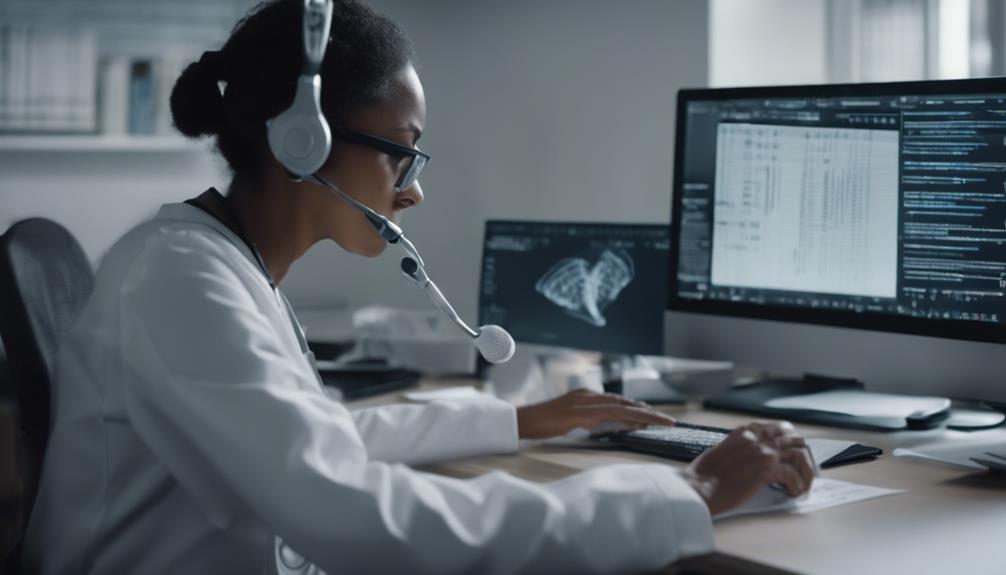When navigating the realm of medical transcription with a virtual assistant, you may find yourself grappling with intricate challenges of using a virtual assistant that go beyond the surface level. The complexities of medical terminology coupled with the necessity for top-notch training programs can lead to a maze of obstacles that require deft navigation. As you venture into this realm, be prepared to encounter a myriad of hurdles that demand your attention and strategic problem-solving skills.
Accuracy Issues
When using a virtual assistant for medical transcription, ensuring accuracy can present significant challenges due to the complexity of medical terminology and the potential for errors in interpretation. To address these challenges, comprehensive training programs are essential for virtual assistants. These programs should focus on enhancing the understanding of medical terminology, grammar rules, and transcription guidelines. Virtual assistants must also be proficient in using specialized transcription software to improve efficiency and accuracy.
Training programs equip virtual assistants with the necessary skills to navigate through complex medical terms and ensure accurate transcriptions. They learn to recognize different accents, dialects, and speech patterns that may affect the transcription process. Additionally, mastering transcription software enables virtual assistants to streamline their workflow, minimize errors, and enhance overall productivity.
Confidentiality Concerns
Ensuring strict confidentiality protocols is paramount when utilizing a virtual assistant for medical transcription tasks. Data security is a critical aspect that must be carefully managed to comply with privacy regulations in the healthcare industry. When sensitive patient information is being transcribed, it is imperative to safeguard it against unauthorized access or breaches. Virtual assistants must adhere to strict data security measures to prevent any compromises in the confidentiality of patient records.
Privacy regulations, such as the Health Insurance Portability and Accountability Act (HIPAA), set clear guidelines for protecting patient data. Virtual assistants handling medical transcription must be well-versed in these regulations to ensure compliance. Encryption, secure networks, and access controls are essential components of maintaining confidentiality in medical transcription processes. Regular audits and monitoring should also be in place to identify and address any potential vulnerabilities in data security.
Quality Control
Maintaining high standards of accuracy is crucial when overseeing quality control in medical transcription tasks. To ensure quality, you should implement robust performance evaluation metrics. Regularly assessing the virtual assistant’s transcription accuracy and adherence to medical terminology standards is essential. Feedback sessions can help address any recurring errors promptly.
Furthermore, data security plays a pivotal role in maintaining quality control. Implementing strict protocols to safeguard patient information is imperative. Regularly remind the virtual assistant about the importance of data confidentiality and the consequences of breaching security protocols. Regular audits of data access and transmission can help identify and rectify any vulnerabilities.
Incorporating quality control measures into the virtual assistant’s workflow is key. By setting clear expectations, providing continuous feedback, and monitoring performance closely, you can enhance the accuracy and reliability of medical transcriptions. Remember, maintaining high-quality standards not only ensures accurate transcriptions but also upholds patient confidentiality and trust.
Time Zone Differences
To effectively manage time zone differences when working with a virtual assistant for medical transcription, coordinate schedules and communication methods to optimize productivity and collaboration. Time zone variances can pose significant challenges to work life balance and productivity. Ensuring that both you and your virtual assistant clearly understand each other’s working hours and availability is crucial. Establishing overlapping hours for real-time communication can help address productivity challenges and foster a collaborative environment.
Balancing work life and personal life can become more intricate with time zone disparities. It is essential to set clear boundaries and expectations regarding after-hours availability to maintain a healthy work-life balance. Productivity challenges may arise due to delays in communication or feedback caused by conflicting work hours. Utilizing project management tools that allow for asynchronous communication can help mitigate these challenges.
Communication Difficulties
You must navigate through potential language barriers when communicating with a virtual assistant, which can lead to misunderstandings. Technical issues such as poor internet connection or software glitches may disrupt communication flow. Be cautious of misinterpretation risks that could impact the accuracy of medical transcriptions.
Language Barriers
Communication breakdowns due to language barriers present significant challenges when utilizing a virtual assistant for medical transcription. Cultural differences and translation challenges can lead to misunderstandings and errors in transcribing medical documents accurately. When language barriers exist, nuances in medical terminology, dialects, or accents may not be accurately interpreted by virtual assistants, impacting the quality and precision of the transcriptions.
Moreover, cultural differences can affect the understanding of context and medical procedures, further complicating the transcription process. Virtual assistants may struggle to grasp the cultural context of certain medical terms or practices, leading to inaccuracies in the transcribed documents. This can result in potential misinterpretations by healthcare professionals relying on these transcriptions for patient care.
To mitigate these language barriers, it is essential to provide comprehensive training and resources to virtual assistants, focusing on medical terminology, dialects, and cultural nuances. Utilizing translation tools and establishing clear communication protocols can also help bridge the gap caused by language barriers when using virtual assistants for medical transcription.
Technical Issues
Technical issues such as network connectivity problems and software glitches can impede the smooth communication flow between virtual assistants and healthcare professionals during medical transcription tasks. Network connectivity plays a crucial role in ensuring real-time interaction between the virtual assistant and the healthcare professional. Poor network connectivity can result in delays, interruptions, or even data loss during transcription sessions, impacting productivity and accuracy. Additionally, software compatibility issues may arise when the virtual assistant’s transcription software is not fully compatible with the healthcare provider’s systems. This can lead to formatting errors, missing data, or other discrepancies in the transcribed medical records. To mitigate these technical challenges, it is essential to conduct regular network checks, use reliable transcription software that is compatible with the healthcare organization’s systems, and provide technical training to virtual assistants to troubleshoot common issues efficiently. By addressing network connectivity and software compatibility issues proactively, the communication flow between virtual assistants and healthcare professionals can be optimized for effective medical transcription tasks.
Misinterpretation Risks
Addressing misinterpretation risks in medical transcription tasks requires a careful consideration of potential communication difficulties that may arise between virtual assistants and healthcare professionals. Virtual assistants, despite their advanced capabilities, may encounter challenges in accurately transcribing medical dictations due to the complexity of medical terminology and the nuances of language used by healthcare professionals. These communication difficulties can lead to potential errors in transcriptions, ranging from misspellings and incorrect interpretations to more critical misunderstandings that could impact patient care.
To mitigate misinterpretation risks, virtual assistants must undergo specialized training to familiarize themselves with medical terminology and enhance their understanding of language nuances commonly used in healthcare settings. Additionally, maintaining open lines of communication between virtual assistants and healthcare professionals can help clarify any uncertainties or ambiguities in dictations, reducing the likelihood of errors in transcriptions. By addressing these communication challenges proactively, virtual assistants can improve the accuracy and reliability of medical transcriptions, ultimately contributing to more efficient healthcare documentation processes.
Training and Onboarding
One crucial aspect to consider when utilizing a virtual assistant for medical transcription is ensuring thorough training and effective onboarding procedures. Proper training is essential to familiarize the virtual assistant with medical terminology, transcription guidelines, and data security protocols. Remote supervision during the initial stages can help monitor the assistant’s progress and address any issues promptly.
Performance evaluation plays a significant role in assessing the virtual assistant’s transcription accuracy, speed, and adherence to quality standards. Establishing clear performance metrics and providing feedback regularly can help improve the assistant’s skills over time. Additionally, ongoing training sessions or refresher courses may be necessary to keep the assistant updated on any changes in medical transcription practices.
Effective onboarding involves creating detailed documentation outlining the expectations, responsibilities, and procedures for the virtual assistant. This documentation should also include information on how to escalate issues, access support, and maintain communication channels. By investing time and resources into training and onboarding, healthcare providers can ensure that their virtual assistants perform efficiently and accurately in medical transcription tasks.
Frequently Asked Questions
How Can Virtual Assistants Handle Complex Medical Terminology?
To handle complex medical terminology, virtual assistants receive extensive terminology training and have access to support resources. Language proficiency is crucial for transcription accuracy. With the right tools and knowledge, virtual assistants can effectively manage medical terminology challenges.
Are There Any Limitations to Using Virtual Assistants for Medical Transcription?
When using virtual assistants for medical transcription, there are limitations to consider. Training requirements are significant due to complex medical terminology. Accuracy challenges may arise, necessitating careful oversight to ensure precision in transcribed records.
Can Virtual Assistants Adapt to Different Medical Specialties?
You’re curious about virtual assistants adapting to different medical specialties. They excel at specialty adaptation but may face terminology challenges. With proper training and industry-specific knowledge, virtual assistants can effectively transcribe diverse medical fields.
What Measures Are in Place to Ensure Data Security?
To ensure data security in medical transcription, data encryption and user authentication protocols are in place. These measures safeguard sensitive information by encoding it and verifying user identities before granting access, protecting patient confidentiality and compliance.
How Do Virtual Assistants Manage Transcription Errors Effectively?
When managing transcription errors effectively, virtual assistants utilize advanced software tools for real-time error detection and correction. By implementing automated proofreading algorithms, transcription accuracy is significantly improved, ensuring high-quality medical documentation.



